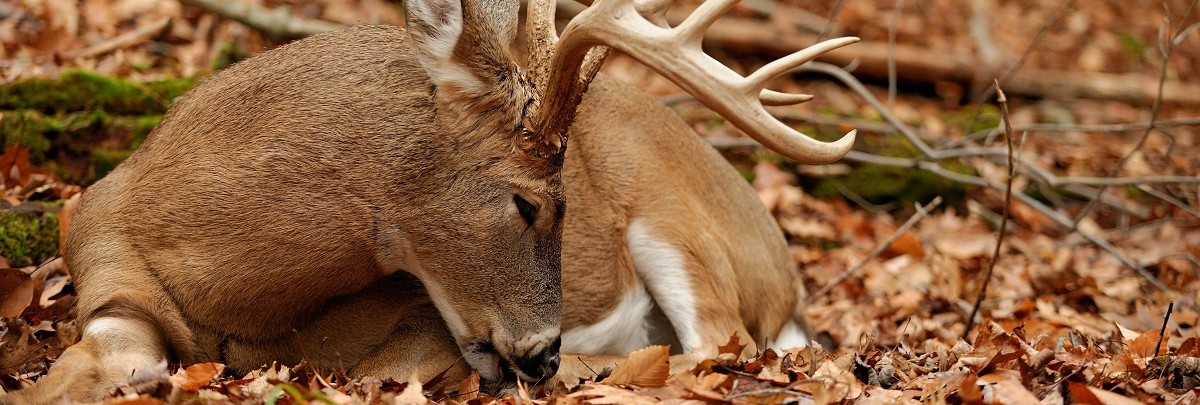What’s the most frequent whitetail behavior? It may come as a surprise to some, but it is bedding and everything associated with the whitetail’s resting time. On average a whitetail beds a whopping 70% of the day. This is the AVERAGE, and the 70% figure does not apply throughout the year. During the dead of winter in the north, whitetails literally go to the edge of hibernation and may bed most of the time. On the other hand lactating does and rutting bucks may bed far less, so the 70% figure is a rough, year-round average.
%20copy.jpg)
Head down, nose in the dirt, this buck is fast asleep.
Hunters are forever talking about whether eyesight, hearing or smelling is the whitetail’s greatest defense mechanism. Though senses help a deer avoid danger, it’s a whitetail’s ability to bed properly that allows them to utilize their senses, so they can keep from getting killed. With this in mind it’s important for hunters and deer/land managers to realize the role a deer’s bedding habits can play when it comes to land development, food source layout and hunting opportunities.
Survival Skill
Usually deer will bed with their back to the wind. There are no wasted senses with whitetails, and by bedding in this manner they can use their eyes to see downwind and their sense of smell to alert them of upwind danger. In hilly country they also have a tendency to bed just over the edge of a ridge if wind is blowing downhill. This allows them to see below and smell their intruder before it sees them.
Through studies done here at our deer research facility, we’ve come to realize that whitetail bucks can smell does from at least 400 yards away. If they can smell another deer from this far away you can bet they can smell man just as far away if conditions are right. So, where they bed allows them to take advantage of their incredible nose.
In many ways deer are like people in that they prefer to bed in the same location over and over. On more than one occasion I’ve seen bucks and does bed, get up to feed, and come right back to the bed they left. I’ve also observed whitetails bedded in the same place day after day and month after month. When it comes to bedding they are definitely creatures of habit if the location provides them with the security they require to survive.
%20copy.jpg)
In order to conserve energy during freezing winter days, a whitetail will spend more of the day bedded down.
Whitetails are very much aware of all that goes on around them when they are bedded, whether they are chewing their cud or dozing. Foreign sounds put them on alert in a second and they can easily differentiate between the footsteps of man and animal. So, just because deer are bedded and resting doesn’t mean their guard is down. Just the opposite is true. When bedded they are more in tune with what is going on around them than with any other behavior they exhibit. The more they bed, the greater their chance of survival.
Once the rut is over and winter arrives, a whitetail’s bedding behavior moves into high gear. From mid-December through March in the North, most whitetails bed over 85% of the time, with the majority of daylight activity occurring just before sunset. During this time it’s all about food and cover. To survive winter’s blasts deer gravitate to south facing environments that are out of the wind to take advantage of sunlight. They also seek out areas where they can access food. When the post-rut arrives it is common to find whitetails bedding within 100 yards of prime food sources, if they have adequate bedding cover nearby.
Rest
Some biologists feel that whitetails do not have to go into a deep sleep like humans to restore their body. Research conducted at Cornell University by Dr. Aaron Moen suggests that when a whitetail’s heart rate drops to their bedding rate of 72 beats per minute they are probably able to build back body cells, whether their eyes are open or not.

Although deer sometimes sleep with their eyes closed, their other senses are still on high alert.
By studying the whitetails on my research facility, I’ve discovered that they do not close their eyes for very long when bedded. Rather, they bed with their eyes open most of the time and periodically close them for very short periods. However, this is not to say that they don’t go into what humans refer to as a deep sleep.
%20copy.jpg)
No, this is not a dead deer, but rather a fully stretched out buck taking a snooze. Deer often times sleep with their eyes wide open.
Though rare, I’ve seen and photographed (above) what I definitely thought was deep sleep. Once I observed a buck that bedded in the normal manner, with his head up. After a few minutes his head began to bob. The buck then stretched his entire body on the ground, like he was dead. After watching him for about thirty minutes I tried to sneak up on the buck. I was able to get within fifteen yards before he came to life and jumped up. The amazing thing is that the buck appeared to have his eyes open the whole time.
Social Behavior
As might be expected there can be a great deal of social interaction that takes place within a whitetail’s bedding area. In addition to chewing their cud and dozing, whitetails exhibit many different forms of behavior from ground level. Probably one of the most frequent things they do is groom. Whitetails use this resting time to bathe by licking themselves. Many times I’ve seen deer spend up to an hour just licking their legs and body.

A buck bathes himself in the midday sun.
I’ve also observed subordinate bucks sparring with bedded mature bucks. This is more common than many hunters believe and occurs from the time velvet peels until antlers are cast.
%20copy.jpg)
A young buck sparring with a mature buck that is bedded down.
Bedded does nursing their fawns is another behavior I’ve observed in the woods. This normally occurs shortly after the birthing process and takes place when the doe is bedded and the fawn wants to nurse.
Does will often interact and groom each other in bedding areas. This kind of doe to doe behavior is much more common than that which takes place in buck bedding areas.

A buck tends a doe during peak rut.
When the breeding phase of the rut explodes, nearly all bedding behavior is dictated by the doe. When a doe is in estrous she knows she’s a marked gal so she tries to bed in the thickest cover possible, limiting her movement to only emergency situations. As a result, bucks bed and move only when the doe moves. Because of this limited activity things can and do move at a snail’s pace during this phase of the rut. In some cases both buck and doe will move less than 50 yards throughout the day if food and cover is close by.







